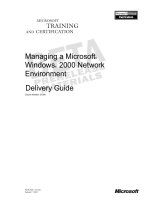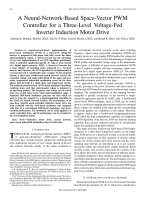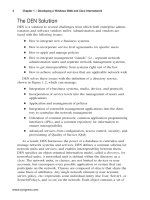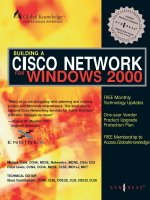en CCNAS v11 ch09 managing a secure network
Bạn đang xem bản rút gọn của tài liệu. Xem và tải ngay bản đầy đủ của tài liệu tại đây (925.97 KB, 75 trang )
Managing a
Secure Network
© 2012 Cisco and/or its affiliates. All rights reserved.
1
Secure End-to-End Network Approach
• Secure network devices with AAA, SSH, role-based CLI, syslog,
SNMP, and NTP.
– Secure services using AutoSecure and one-step lockdown.
© 2012 Cisco and/or its affiliates. All rights reserved.
2
Secure End-to-End Network Approach
• Protect network endpoints, such as workstations and servers, against
viruses, Trojan Horses, and worms with Cisco NAC, Cisco IronPort,
and Cisco Security Agent.
© 2012 Cisco and/or its affiliates. All rights reserved.
3
Secure End-to-End Network Approach
• Use Cisco IOS Firewall and accompanying ACLs to secure resources
internally while protecting those resources from outside attacks.
© 2012 Cisco and/or its affiliates. All rights reserved.
4
Secure End-to-End Network Approach
• Supplement Cisco IOS Firewall with Cisco IPS technology to evaluate
traffic using an attack signature database.
© 2012 Cisco and/or its affiliates. All rights reserved.
5
Secure End-to-End Network Approach
• Protect the LAN by following Layer 2 and VLAN recommended
practices and by using a variety of technologies, including BPDU
guard, root guard, PortFast, and SPAN.
© 2012 Cisco and/or its affiliates. All rights reserved.
6
Secure End-to-End Network Approach
• Where are all of these security approaches documented?
© 2012 Cisco and/or its affiliates. All rights reserved.
7
Security Policies!
• Create and maintain security policies to mitigate existing as well
as new kinds of attacks.
• These policies enforce a structured, informed, consistent
approach to securing the network.
• Security policies must answer to the following:
– Business needs
– Threat Identification
– Risk analysis
– Security needs
– Industry-recommended practices
– Security operations
© 2012 Cisco and/or its affiliates. All rights reserved.
8
Security Policies Must Answer …
• Business needs:
– What does the organization want to do with the network?
– What are the organizational needs?
• Threat identification:
– What are the most likely types of threats given the organization's purpose?
• Risk analysis:
– What is the cost versus benefit analysis of implementing various security
technologies?
– How do the latest security techniques affect the network environment and
what is the risk if they are not implemented?
© 2012 Cisco and/or its affiliates. All rights reserved.
9
Security Policies Must Answer …
• Security needs:
– What are the policies, standards, and guidelines needed to address business
needs and risks?
• Industry-recommended practices:
– What are the reliable, well-understood, and recommended security practices
that similar organizations currently employ?
• Security operations:
– What are the current procedures for incident response, monitoring,
maintenance, and auditing of the system for compliance?
© 2012 Cisco and/or its affiliates. All rights reserved.
10
Identifying
Threats and
Risk Analysis
© 2012 Cisco and/or its affiliates. All rights reserved.
11
Identifying Threats
• When identifying threats, it is important to ask two questions:
– What are the possible vulnerabilities of a system?
– What are the consequences if system vulnerabilities are exploited?
© 2012 Cisco and/or its affiliates. All rights reserved.
12
Risk Analysis
• Risk analysis is the systematic study of uncertainties and risks.
– It identifies the risks, determines how and when those risks might arise, and
estimates the impact (financial or otherwise) of adverse outcomes.
• After the threats are evaluated for severity and likelihood, the
information is used in a risk analysis.
© 2012 Cisco and/or its affiliates. All rights reserved.
13
Risk Analysis
• There are two types of risk analysis in information security:
© 2012 Cisco and/or its affiliates. All rights reserved.
14
Qualitative Risk Analysis
• Various ways of conducting qualitative risk analysis exist.
• One method uses a scenario-based model.
– This approach is best for large cities, states, and countries because it is
impractical to try to list all the assets, which is the starting point for any
quantitative risk analysis.
– For example, by the time a typical national government lists all of its assets,
the list would have hundreds or thousands of changes and would no longer
be accurate.
• With qualitative risk analysis, research is exploratory and cannot
always be graphed or proven mathematically.
– It focuses mostly on the understanding of why risk is present and how various
solutions work to resolve the risk.
© 2012 Cisco and/or its affiliates. All rights reserved.
15
Quantitative Risk Analysis
• Quantitative risk analysis uses a mathematical model that assigns
a monetary figure to:
– The value of assets
– The cost of threats being realized
– The cost of security implementations
• It relies on specific formulas to determine the value of the risk
decision variables.
© 2012 Cisco and/or its affiliates. All rights reserved.
16
Quantitative Risk Analysis Formulas Include:
• Single Loss Expectancy (SLE)
– Represents the expected loss from a single occurrence of the threat.
• Asset Value (AV)
– This includes the cost of development / purchase price, deployment, and maintenance.
• Exposure Factor (EF)
– An estimate of the degree of destruction that could occur.
• Annualized Loss Expectancy (ALE)
– Addresses the cost to the organization if it does nothing to counter existing threats.
• Annualized Rate of Occurrence (ARO)
– Estimates the frequency of an event and is used to calculate the ALE.
© 2012 Cisco and/or its affiliates. All rights reserved.
17
Quantitative Risk Analysis
Data entry error
– Exposure Factor is:
.001 percent
– AV of the enterprise is:
$1,000,000
– SLE is: $1,000,000 * .00001
– SLE is equal to:
© 2012 Cisco and/or its affiliates. All rights reserved.
$ 10
18
Quantitative Risk Analysis
Flood threat
– Exposure Factor is:
60 percent
– AV of the enterprise is:
$10,000,000
– SLE is: $10,000,000 * .60
– SLE is equal to:
© 2012 Cisco and/or its affiliates. All rights reserved.
$ 6,000,000
19
Quantitative Risk Analysis
Annualized Loss Expectancy
Annualized Rate of Occurrence
Data entry error
– SLE is:
$ 10
– ARO is: 125,000
– ALE is: $10 * 125,000
– ALE is equal to:
© 2012 Cisco and/or its affiliates. All rights reserved.
$ 1,250,000
20
Quantitative Risk Analysis
Annualized Loss Expectancy
Annualized Rate of Occurrence
Flood threat
– SLE is:
$ 6,000,000
– ARO is: .01
– ALE is: $ 6,000,000 * .01
– ALE is equal to:
© 2012 Cisco and/or its affiliates. All rights reserved.
$ 60,000
21
Quantitative Risk Analysis
• It is necessary to perform a quantitative risk analysis for all
threats identified during the threat identification process.
• Then prioritize the threats and address the most serious first.
– This prioritization enables management to focus resources where they do the
most good.
© 2012 Cisco and/or its affiliates. All rights reserved.
22
Risk
Management
and Risk
Avoidance
© 2012 Cisco and/or its affiliates. All rights reserved.
23
Risk Management and Risk Avoidance
• When the threats are identified and the risks are assessed, a
protection strategy must be deployed to protect against the risks.
• There are two very different methods to handle risks:
– Risk management
– Risk avoidance
© 2012 Cisco and/or its affiliates. All rights reserved.
24
Risk Management
• Method deploys protection mechanisms to reduce risks to
acceptable levels.
• Risk management is perhaps the most basic and the most difficult
aspect of building secure systems, because it requires a good
knowledge of risks, risk environments, and mitigation methods.
© 2012 Cisco and/or its affiliates. All rights reserved.
25









